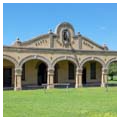Founded by Captain Richard King in 1853, the ranch originated with his purchase of the Santa Gertrudis land grant that dated to the Spanish colonial period. The initial 15,500 acres purchased by King, which follow the ten-mile-long Santa Gertrudis Creek, remain as the nucleus of the ranch to this day. Almost clairvoyant, King and his partner, Mifflin Kenedy, sensing the future demand for cattle and its byproducts, began to systematically invest the profits of their river steamboat monopoly on the Rio Grande in the purchase of grazing lands bordering the Gulf Coast. Further profiting from the smuggling of Confederate cotton during the Civil War, and the opening of northern beef markets after the war, King and Kenedy continued their ravenous acquisition of land to the point that, by 1885, at the time of King's death, he had amassed and fenced 614,140 acres. The ranch now encompasses 825,000 acres—nearly the size of the state of Rhode Island.
King's multiple enterprises—financing the Corpus Christi to Laredo railroad, improving his cattle breeds, and deepening the port of Corpus Christi—centered on enhancing his ranching interests by connecting the South Texas plains to the rest of the state and nation. Those interests were adeptly promoted by his widow, Henrietta M. King—who would outlive her iconic husband by forty years—and by Robert J. Kleberg, who married Alice, Captain King's youngest daughter.
Insightful and dedicated, Kleberg, the lawyer–turned–ranch manager, pursued the same strategies pioneered by Captain King. Always under the watchful eye of Mrs. King, Kleberg went further and diversified the interests of the ranch. Drilling artesian wells across the property at the end of the nineteenth century, Kleberg found a stable source of water, thus guaranteeing both the viability of the ranch and the opening of South Texas to outside investment, especially the coveted railroad.
By 1903, Mrs. King had donated seventy-five thousand acres of land for urban and agricultural development, and for laying the line of the St. Louis, Brownsville and Mexico Railway all the way to the Rio Grande. Profits from these ventures were invested in new land acquisitions for the ranch, which reached the one-million-acre mark in 1906. The ranch had been larger, but land was sold to form area town sites. So gargantuan was its size that 80 percent of the new Kleberg County, created in 1913, was encompassed by the lands of the King Ranch. Restructured in 1935 as King Ranch Incorporated, the heirs of King and Kleberg continue to profit from the business ventures initiated by their ancestors, while expanding the original cattle enterprise into oil and gas production, wildlife conservation, raising thoroughbreds, and acquisition of ranches overseas.
Writing Credits
If SAH Archipedia has been useful to you, please consider supporting it.
SAH Archipedia tells the story of the United States through its buildings, landscapes, and cities. This freely available resource empowers the public with authoritative knowledge that deepens their understanding and appreciation of the built environment. But the Society of Architectural Historians, which created SAH Archipedia with University of Virginia Press, needs your support to maintain the high-caliber research, writing, photography, cartography, editing, design, and programming that make SAH Archipedia a trusted online resource available to all who value the history of place, heritage tourism, and learning.




